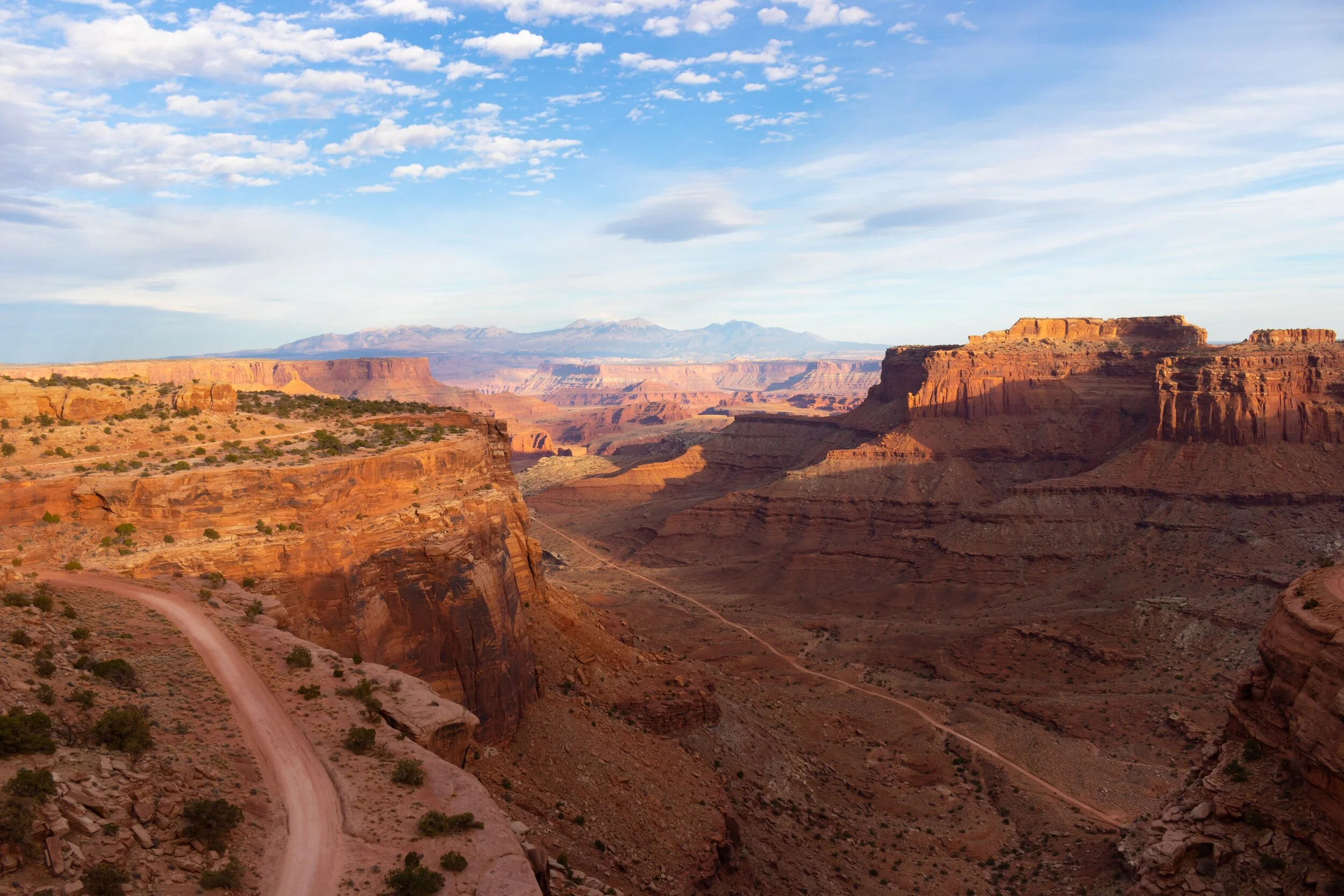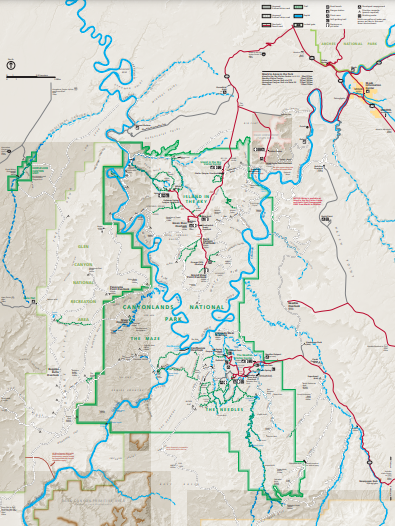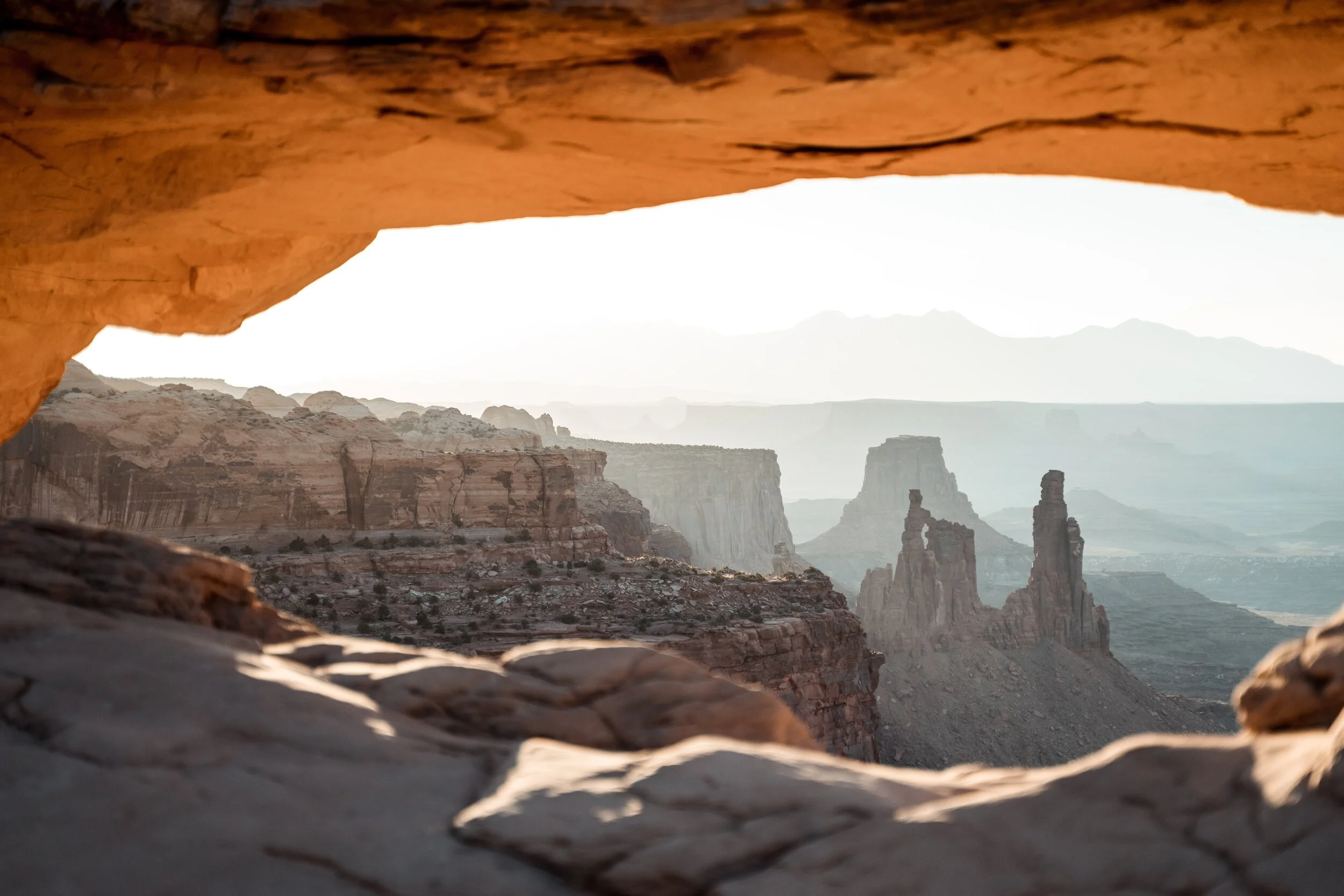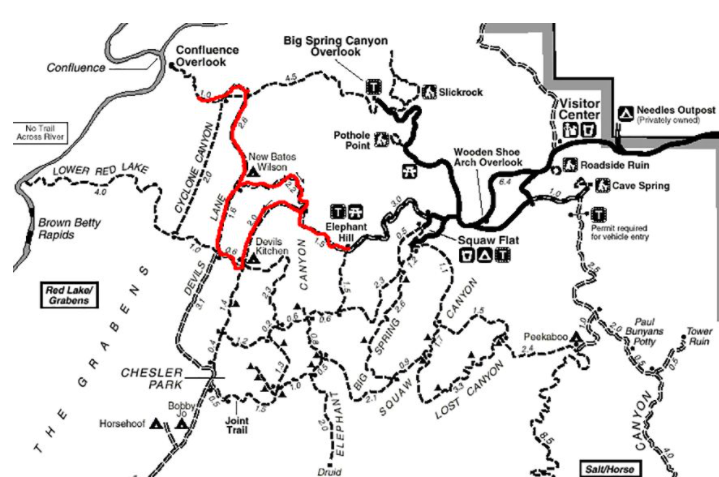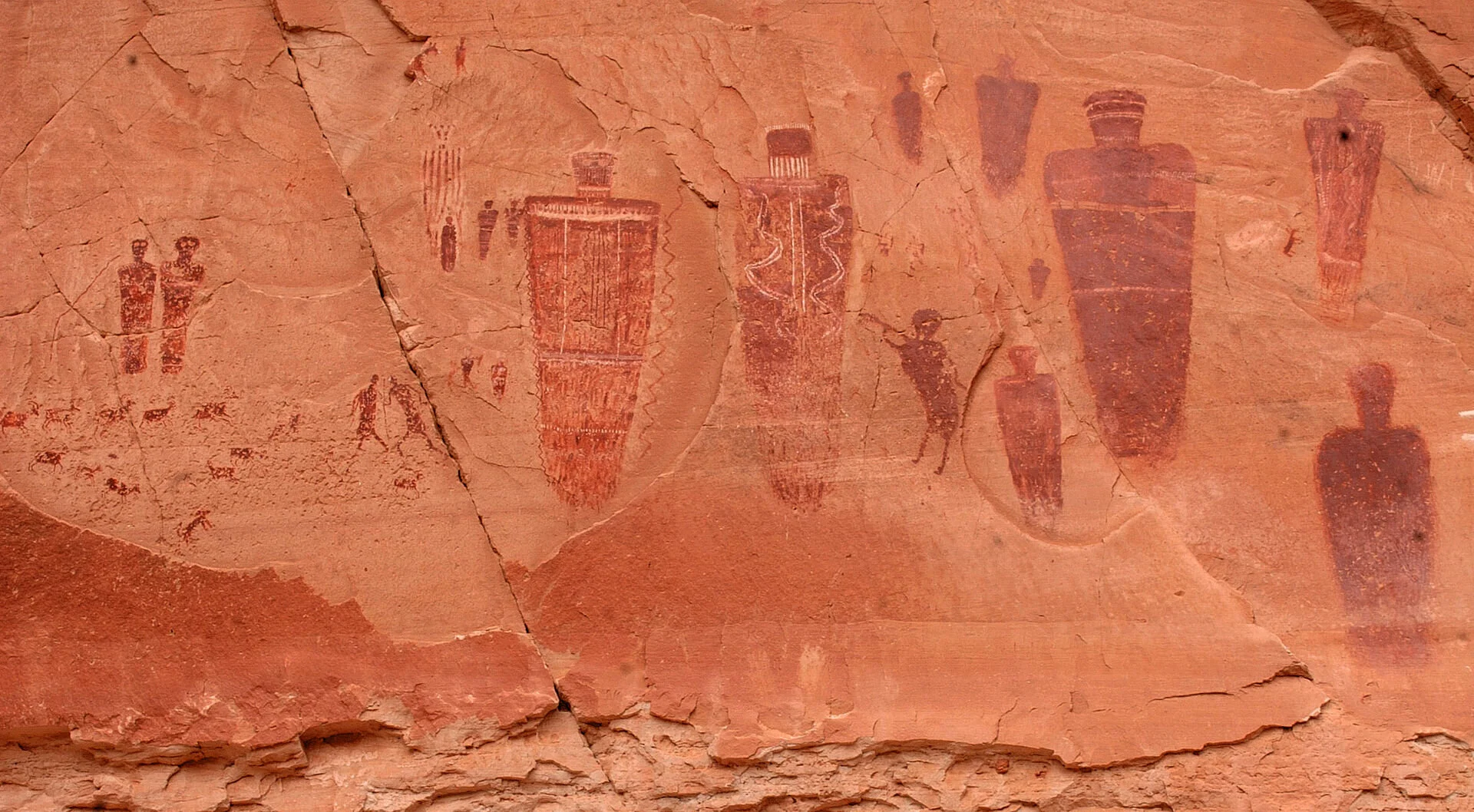Visiting Canyonlands National Park
COLORFUL LANDSCAPES & VAST LONELY CANYONS
“If future generations are to remember us with gratitude rather than contempt, we must leave them something more than the miracles of technology. We must leave them a glimpse of the world as it was in the beginning not just after we got through with it.”
- President Lyndon B. Johnson
Tucked away on a trail in the rugged, remote terrain of Canyonlands National Park lies a sign with this quote. It continues, “here at the end of the road, we encourage you to step into the wilderness and explore what it means to you.”
Standing there in what felt like the middle of nowhere, this sign struck a cord and I took a photo of it. Little did I know one day I would start a travel blog and revert back to it. For you see, standing in Canyonlands is an experience unlike any other park. It has this great sense of desolation as if you really have come to the end of the road and are walking into something completely unworldly, wild and vast.
[Note: This post may contain affiliate links.]
Green River Overlook - Wikipedia
Canyonlands is over 330,000 acres of dramatic desert in southeastern Utah. Its sandstone walls were carved out by the Colorado River and its tributaries much like Grand Canyon and eroded with time, leaving behind an Island in the Sky, a huge flat-topped mesa full of panoramic outlooks, and miles of maze-like canyons, sheer cliff drop-offs, pinnacles and flats. It’s a red rock paradise of sweeping, jaw-dropping views, wind-swept rocks and plateaus, where the Green River and the Colorado intersect.
BRIEF HISTORY OF THE PARK
On September 12, 1964, President Lyndon B. Johnson signed Public Law 85-890 establishing Canyonlands National Park. Originally, the park covered about 257,000 acres but with the addition of the Horseshoe Canyon Annex in 1971, it grew to over 330,000.
The vast canyons making up the park were carved out by the Green and Colorado Rivers and their tributaries which exposed layers of buried sediment that slowly began eroding away leaving behind the incredible mesas, pinnacles, flats, buttes and spires that cover its current landscape. A true geological gold mine.
KNOW BEFORE YOU GO
Operating Hours
Canyonlands is open all day every day, 365 days a year. It never closes.
Plan Ahead
Canyonlands is unlike most other national parks in that it is very isolated and extremely vast. It requires much more planning than most. This is not to say you can’t do a quick visit and drive through parts of it, but if you really want to spend some time there, you will definitely want to do your research. Below are some important things to know and consider before going.
4 Wheel Drive
Most of Canyonlands is inaccessible without a high clearance, low range four-wheel drive vehicle. Many roads are considered extremely technical to navigate and may experience flooding, snow, ice, deep sand, ledges and rock falls. Road conditions can change quickly and unexpectedly. Back country roads with obstructions and hazards may take maintenance a while to clear. Often times, chains and winches become necessary.
Roads requiring 4WD include: Elephant Hill, Salt Creek, Horse Creek, Davis Canyon, Lavender Canyon, Colorado Overlook, and the White Rim.
Water
Water is an extremely scarce resource within the boundaries of the park. Although water is available at the Island in the Sky and Needles Visitor Centers, there is no water available elsewhere so be sure to bring plenty with you.
Canyonlands is a dry desolate place, and can be extremely hot in the summer when temperatures can easily reach over 100° F. Come prepared. Note that even the Rangers Stations do not have water.
Park Passes
Entrance fees (subject to change) are as follows:
Private Vehicle - $30
Motorcycle - $25
Pedestrian or Bicycle - $15 per person
Several other passes can be used as follows:
Southeast Utah Annual Park Pass (Arches, Canyonlands, Natural Bridges NM, Hovenweep NM) - $55
Annual National Park Pass - $80 (your pass to more than 2,000 federal rec sites including entrance fees to national parks and national forests)
Military Annual Pass - Free
Annual 4th Grade Pass – Free
Lifetime Senior Pass (62 and older) - $80
Annual Senior Pass (62 and older) - $20
Lifetime Access Pass (for those with permanent disability) - Free
Island in the Sky
Permits
Much of Canyonlands is undeveloped rugged terrain. All overnight trips into its backcountry require permits which may be challenging to obtain during peak season (spring and fall). Reservations are not required but are highly recommended as space is limited.
Reservations can be made through Recreation.gov up to 2 days prior to your visit. I highly recommend reserving a permit 4 months in advance of the season in which you plan to visit when they first become available. Below is the schedule.
Spring (March 10 to June 9) - Reservations open November 10
Summer (June 10 to September 9) - Reservations open February 10
Fall (September 10 to December 9) - Reservations open May 10
Winter (December 10 to March 9) - Reservations open August 10
Important Notes:
Day use permits are required for White Rim Road, Elephant Hill, Lavender Canyon and Peekaboo/Horse Canyon roads even if you do not plan on staying overnight.
Your reservation is not your permit. You will receive instructions on where to obtain it once your reservation is complete.
Permits are NOT valid on mobile devices. You must have a signed, printed copy in your possession at all times.
Permits not reserved in advance may be available on a first-come, first-serve basis at the Visitor Centers.
Canyonlands Back Country - Unsplash
Temperatures
Canyonlands is considered a high desert meaning temperatures drop dramatically from day to night, as much as 40° F in a single day during all times of year. So, be sure to check the weather before leaving home.
Winters in Canyonlands can be extremely cold. Temps rarely reach over 50° F in the day and often drop near zero at night. Snow is rare and quite beautiful but be warned, even a light snow can close trails and make roads impassable. When traveling in Winter, always check road conditions in advance.
Summers in Canyonlands can reach scorching temperatures of over 100° F and often see summer monsoons with flash floods. If you plan to visit in the summer, bring plenty of water, do not engage in extremely strenuous exercise and if rain is predicted, avoid areas like slot canyons and locations prone to flash floods.
Spring and Fall are the best times to visit. From April to May and September to October, highs average 60-80° F and lows average 30-50° F.
WHERE TO STAY
Campgrounds Within the Park
There are 2 campgrounds inside Canyonlands National Park including the following:
Island in the Sky (Willow Flat) Campground – 12 individual sites. First come, first serve. Open year round near the spectacular Green River Overlook. Toilets, picnic tables, fire rings. No water.
The Needles Campground – 26 individual sites and 3 group sites. You can reserve some sites in spring and fall. Other times of year, they are first come, first serve. Group sites can be reserved mid-March to mid-November. Toilets, picnic tables, fire rings.
BLM Campgrounds - There are also quite few BLM campgrounds in the vicinity.
A great way to find campgrounds, especially when offline, is to download the Dyrt PRO, probably the largest campground search platform around with reviews and tips.
Highway 211 Campgrounds – Creek Pasture Campground, Hamburger Rock Campground, Superbowl Campground (including group sites)
Highway 128 Campgrounds – Goose Island Campground, Grandstaff Campground, Drinks Canyon Campground, Hal Canyon Campground, Oak Grove Campground, Big Bend Campground, Upper Big Bend Campground, Upper Onion Creek Campground, Lower Onion Campground
Backcountry Camping – There is extensive backcountry camping throughout Canyonlands that can be used for backpacking, 4-wheel drives, boating or bicycling. There are literally hundreds of miles of hiking trails with designated backcountry campsites, but you will need a permit for overnight trips.
Dead Horse State Park - There are also several campgrounds at the neighboring Dead Horse State Park including Kayenta Campground, Wingate Campground and the Moenkopi Yurts.
Private Camping Outside Canyonlands – There are many private campgrounds near Canyonlands.
One of those is Glamping Canyonlands, a private campground providing a unique off-grid camping experience located half way between Arches National Park/Moab and Needles District, Canyonlands.
Glamping Canyonlands is run by husband and wife team, Keshia and Erik Joot, who first visited the Needles District on their honeymoon in 2012 and returned years later to live their dream. I absolutely adore Keshia who has become a friend of mine, and live vicariously through them as I would love to do what they’ve done.
Hotels/Motels
The closest cities to Canyonlands NP with lodging are Moab and Monticello. Both offer numerous hotels, motels, B&Bs and vacation rentals.
REGIONS OF THE PARK
PDF Map of Canyonlands
Canyonlands is so vast that it’s divided into distinct districts - Island in the Sky, The Needles, The Maze, Horseshoe Canyon Unit and the rivers that divide them. It literally takes hours traveling between the districts so unless you have unlimited time, you may want to consider focusing solely on one district for each visit to the park. Despite their proximity as a crow flies, there are no roads directly linking the districts together. It can take 2-6 hours by car traveling between them with limited spots that allow river crossing.
ISLAND IN THE SKY
Island in the Sky
The Island in the Sky mesa sits atop 1,000 foot tall sandstone cliffs overlooking the valley below. There are numerous scenic outlooks along the island each offering unique perspectives of the picturesque canyons that were carved out below.
Island in the Sky is the most accessible part of the park. It is close to Moab and most of it is easily accessible without 4-wheel drive. There are paved scenic drives with numerous hiking spots. It’s a perfect spot for a day trip or if you have limited time.
Island in the Sky Visitor Center and Natural History Association bookstore offers exhibits, publications, park information and an orientation video. You can also pick up permits here for the backcountry. This is also one of the few spots that has water.
Things to Do
Grand View Point Overlook - Have you ever stood at the edge of the ocean feeling ever so small in this vast universe of ours? A hike to Grand View Point Overlook will magnify that feeling times ten. The overlook sits at the end of a mile-long sandstone staircase offering panoramic views of red rock spires against azure skies. It is at the southernmost point of the island with sweeping views of distant mountains, basins and canyons as well as White Rim Road.
From the Island of the Sky Visitor Center, drive south 12 miles to the end of the road. From the parking lot, you can walk along the 100-yard trail to the first viewpoint if you’re looking for an easy hike. From here, an unpaved trail takes you out another mile down stairs to the cliff’s edge to a second viewpoint.
From spring to fall, you can take a ranger led hike and learn about the area’s geology.
Mesa Arch - Unsplash
Mesa Arch
Mesa Arch sits right on the edge of a 500-foot cliff with vast canyon views. The La Sal Mountains off in the distance provide a magnificent backdrop. It’s quite popular at dawn as the sun rises on the horizon behind the arch lighting up the red sandstone in golden tones.
The parking lot for the Mesa Arch Trail is 6.3 miles south of the Island in the Sky Visitor Center, before Upheaval Dome Road.
Tips: Do not walk or climb on the arch. It is strictly prohibited. This is a great hike for kids but the parking lot fills up quickly especially at sunrise.
Shafer Trail
Shafer Trail
If you’re traveling through Canyonlands in a 4WD vehicle or mountain biking, Shafer Trail is an incredible unpaved backcountry road that will leave you in awe and provide opportunities to see wildlife. If not, you will still want to travel to the turn off to get a great view of the iconic route as it winds down 1,500 feet of colorful sandstone walls along a massive cliff.
It was named after the Shafer family, early Mormon settlers who moved cattle down this route to lower elevation to escape the harsh winters. However, it was actually first used by Native Americans to reach the mesa, followed by sheep herders moving flocks to better pastures. It was even used at one point to transport uranium-bearing rock to market. Today it’s a fun challenging road for thrill seekers.
The 19.6 mile road starts 0.9 miles past the Visitor Center and is moderately trafficked. 4WD and low range gear (4LO) is strongly recommended as the road can be quite treacherous. Speed limit is 15 mph, seatbelts are mandatory and uphill traffic has the right of way.
THE NEEDLES
The Needles is an area of incredibly beautiful backcountry but to reach its hidden gemstones, you will need 4-wheel drive or a boat to access it. Hiking in this District is also more strenuous than other areas of the park.
The Needles is renowned for its incredible pinnacles and pictographs and a perfect area for backpacking.
Things to Do:
Lavender Canyon
The road through Lavender Canyon follows the canyon bottom and is full of deep sand, deep water and quicksand. If you have the vehicle to navigate it, the hazards are worth exploring this incredible area as there are a wealth of arches and archaeological sites to see, some of which can be seen right off the road.
The road is usually too sandy for mountain bikes and includes two major creek crossings with steep banks. A backcountry permit is required even for day use.
Interestingly enough, you will find no lavender fields growing here despite its name.
Elephant Hill Trail
Elephant Hill is probably the most technical four-wheel drive road in all of Utah. The road is full of steep grades, loose gravel, stair-step drops and hairpin turns. It’s quite tricky to maneuver.
The trail is about 14.5 miles long. Maximum vehicle length including racks is 21 feet and 4WD is mandatory. There is no water at any of the campsites nearby and it gets very hot in summer so bring plenty of fluids. A backcountry permit is required even for day use.
THE MAZE
The Maze is an extremely remote area of the park to the west of the Green River that is completely isolated and a haven for remote backpacking, strenuous hiking and off roading. It is the least accessible district of Canyonlands that receives the fewest visitors.
The Maze itself is 30 square miles of of sheer 600-foot walled canyons that wind about, twisting and dividing back upon themselves that can only be explored by foot. This slew of interwoven canyons often lead to dead ends and is often referred to as a “thirty mile puzzle in sandstone.”
Like many areas of Canyonlands, GPS often leads one astray, so be sure to take a topographical map of the area so you don’t get lost. It can literally take rescuers up to 3 days to reach hikers in an emergency here so this is not the area for the faint of heart, ill-prepared or amateur hiker. It is that remote.
The Maze District - Wikipedia
Things to Do:
Maze Overlook Trail
A trail of massive sandstone fins and ruby red canyons with views of the Green and Colorado Rivers converging. You will also find incredible petroglyphs and unbelievable beauty.
This 8 mile, moderately trafficked trail like many others in the Maze area of Canyonlands will take you along steep exposed rocks and pour-offs. It requires basic climbing maneuvers, scrambling or rope to navigate, and cairns may not easily mark the trail. Many spots look alike so you will need a topographical map to avoid getting lost. Water is also extremely scarce so come prepared.
Just getting to the trail head is a 6-hour, 4WD journey.
HORSESHOE CANYON
Great Gallery - Wikipedia
Horseshoe Canyon is best known for its significant archaic rock art, probably some of the most intricate, well-preserved designs in all of North America.
Two-wheel drive roads can usually make it to Horseshoe Canyon but do not rely on GPS. Make sure to take a map instead.
Things to Do:
Great Gallery - Wikipedia
Great Gallery
The Great Gallery is the best known and most spectacular panel of both Barrier Canyon style pictographs and petroglyphs in Horseshoe Canyon. At over 200 feet long, the extensive panel is extremely well-preserved containing life-size figures with intricate designs believed to be 1,500-4,000 years old.
The hike is approximately 7 mile long, accessible year round. There is a steep descent of almost 800 feet at the beginning of the trail so be prepared to hike back up it at the end. It is recommended that you take at least a gallon of water per person.
You can camp at the west rim trailhead on BLM land here but camping within the park boundary is prohibited.
THE RIVERS OF CANYONLANDS
Looking to explore the rivers of Canyonlands? The Colorado and Green Rivers wind through the heart of Canyonlands, often hidden from view by the complex contours of the unique landscape and not easily accessible.
To launch on the Colorado from here, boaters can use the Potash or Moab ramps. To launch on the Green River, boaters can use Green River State Park, Ruby Ranch (call 435-564-3633) or Mineral Bottom ramps. There is no vehicle access near the Confluence or in Cataract Canyon.
To book river rafting tours, a great place to start is through the National Park Service’s Commercial Guides list.
Read More…
Related Stories:
How We Almost Didn’t Make it to Canyonlands Alive - A funny story about our mishaps
Too Late to Stop - An Eerie Night Headed to Death Valley
Things to Do Nearby:
Newspaper Rock - One of The World’s Largest Concentrations of Petroglyphs






